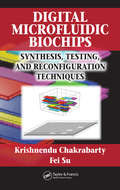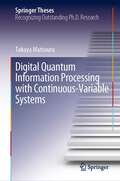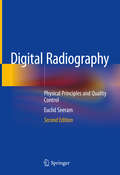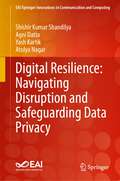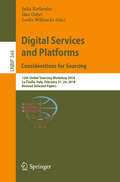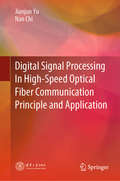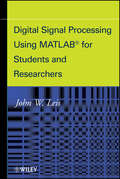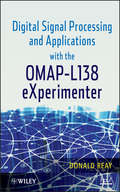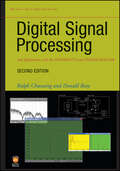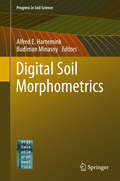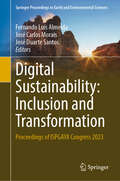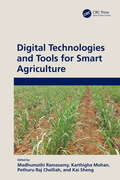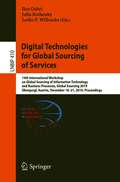- Table View
- List View
Digital Microfluidic Biochips: Design Automation and Optimization
by Krishnendu Chakrabarty Tao XuMicrofluidics-based biochips combine electronics with biochemistry, providing access to new application areas in a wide variety of fields. Continued technological innovations are essential to assuring the future role of these chips in functional diversification in biotech, pharmaceuticals, and other industries.Revolutionary guidance on design, opti
Digital Microfluidic Biochips: Synthesis, Testing, and Reconfiguration Techniques
by Krishnendu Chakrabarty Fei SuDigital Microfluidic Biochips focuses on the automated design and production of microfluidic-based biochips for large-scale bioassays and safety-critical applications. Bridging areas of electronic design automation with microfluidic biochip research, the authors present a system-level design automation framework that addresses key issues in the design, analysis, and testing of digital microfluidic biochips. The book describes a new generation of microfluidic biochips with more complex designs that offer dynamic reconfigurability, system scalability, system integration, and defect tolerance. Part I describes a unified design methodology that targets design optimization under resource constraints. Part II investigates cost-effective testing techniques for digital microfluidic biochips that include test resource optimization and fault detection while running normal bioassays. Part III focuses on different reconfiguration-based defect tolerance techniques designed to increase the yield and dependability of digital microfluidic biochips. Expanding upon results from ongoing research on CAD for biochips at Duke University, this book presents new design methodologies that address some of the limitations in current full-custom design techniques. Digital Microfluidic Biochips is an essential resource for achieving the integration of microfluidic components in the next generation of system-on-chip and system-in-package designs.
Digital Molecular Magnetic Resonance Imaging (Series in BioEngineering)
by Michael O. Dada Bamidele O. AwojoyogbeThis book pushes the limits of conventional MRI visualization methods by completely changing the medical imaging landscape and leads to innovations that will help patients and healthcare providers alike. It enhances the capabilities of MRI anatomical visualization to a level that has never before been possible for researchers and clinicians. The computational and digital algorithms developed can enable a more thorough understanding of the intricate structures found within the human body, surpassing the constraints of traditional 2D methods. The Physics-informed Neural Networks as presented can enhance three-dimensional rendering for deeper understanding of the spatial relationships and subtle abnormalities of anatomical features and sets the stage for upcoming advancements that could impact a wider range of digital heath modalities. This book opens the door to ultra-powerful digital molecular MRI powered by quantum computing that can perform calculations that would take supercomputers millions of years.
Digital PCR: Methods And Protocols (Methods in Molecular Biology #1768)
by George Karlin-Neumann Francisco BizouarnThis volume explores and explains how digital PCRs (dPCRs) help in the study of numerous topics, such as infectious diseases, evolution of cancer and treatment responses, somatic mosaicism, genome editing and cell therapy, and food testing for GMOs and pathogens. Written in the highly successful Methods in Molecular Biology series format, chapters include introductions to their respective topics, lists of the necessary materials and reagents, step-by-step, readily reproducible laboratory protocols, and tips on troubleshooting and avoiding known pitfalls.Authoritative and thorough, Digital PCR: Methods and Protocols is a valuable resource for specialists in various fields, including geneticists, neurologists, immunologists, oncologists, and researchers who are interested in environmental sciences.”
Digital Phenotyping and Mobile Sensing: New Developments in Psychoinformatics (Studies in Neuroscience, Psychology and Behavioral Economics)
by Christian Montag Harald BaumeisterThis book offers a snapshot of cutting-edge applications of mobile sensing for digital phenotyping in the field of Psychoinformatics. The respective chapters, written by authoritative researchers, cover various aspects related to the use of these technologies in health, education, and cognitive science research. They share insights both into established applications of mobile sensing (such as predicting personality or mental and behavioral health on the basis of smartphone usage patterns) and emerging trends. Machine learning and deep learning approaches are discussed, and important considerations regarding privacy risks and ethical issues are assessed. In addition to essential background information on various technologies and theoretical methods, the book also presents relevant case studies and good scientific practices, thus addressing researchers and professionals alike. To cite Thomas R. Insel, who wrote the foreword to this book: “Patients will only use digital phenotyping if it solves a problem, perhaps a digital smoke alarm that can prevent a crisis. Providers will only use digital phenotyping if it fits seamlessly into their crowded workflow. If we can earn public trust, there is every reason to be excited about this new field. Suddenly, studying human behavior at scale, over months and years, is feasible.”
Digital Phenotyping and Mobile Sensing: New Developments in Psychoinformatics (Studies in Neuroscience, Psychology and Behavioral Economics)
by Christian Montag Harald BaumeisterThis book offers a snapshot of cutting-edge applications of digital phenotyping and mobile sensing for studying human behavior and planning innovative e-healthcare interventions. The respective chapters, written by authoritative researchers, cover both theoretical perspectives and good scientific and professional practices related to the use and development of these technologies. They share novel insights into established applications of mobile sensing, such as predicting personality or mental and behavioral health on the basis of smartphone usage patterns, and highlight emerging trends, such as the use of machine learning, big data and deep learning approaches, and the combination of mobile sensing with AI and expert systems. Important issues relating to privacy and ethics are analyzed, together with selected case studies. This thoroughly revised and extended second edition provides researchers and professionals with extensive information on the latest developments in the field of digital phenotyping and mobile sensing. It gives a special emphasis to trends in diagnostics systems and AI applications, suggesting important future directions for research in public health and social sciences.
Digital Quantum Information Processing with Continuous-Variable Systems (Springer Theses)
by Takaya MatsuuraThe book provides theoretical methods of connecting discrete-variable quantum information processing to continuous-variable one. It covers the two major fields of quantum information processing, quantum communication and quantum computation, leading to achievement of a long-sought full security of continuous-variable quantum key distribution (QKD) and proposal of a resource-efficient method for optical quantum computing. Firstly, the book provides a security of continuous-variable QKD against arbitrary attacks under a realistic condition such as finite communication rounds and the use of digitized information processing. The book also provides the unified view for conventionally used approximate Gottesman-Kitaev-Preskill (GKP) codes, which encodes qudits on a continuous-variable system, enabling direct comparison between researches based on different approximations. The book finally proposes a resource-efficient method to realize the universal optical quantum computation using the GKP code via the direct preparation of the GKP magic state instead of GKP Pauli states. Feasibility of the proposed protocol is discussed based on the existing experimental proposals for the GKP state preparation.
Digital Radiography: Physical Principles and Quality Control
by Euclid SeeramThis is the second edition of a well-received book that enriches the understanding of radiographers and radiologic technologists across the globe, and is designed to meet the needs of courses (units) on radiographic imaging equipment, procedures, production, and exposure. The book also serves as a supplement for courses that address digital imaging techniques, such as radiologic physics, radiographic equipment and quality control. In a broader sense, the purpose of the book is to meet readers’ needs in connection with the change from film-based imaging to film-less or digital imaging; today, all radiographic imaging worldwide is based on digital imaging technologies. The book covers a wide range of topics to address the needs of members of various professional radiologic technology associations, such as the American Society of Radiologic Technologists, the Canadian Association of Medical Radiation Technologists, the College of Radiographers in the UK, and the Australian and New Zealand Societies for Radiographers.
Digital Radiography: Review Questions
by Euclid SeeramThis book serves as a supplement to the book ‘Digital Radiography: Physical Principles and Quality Control, 2nd Edition (ISBN 978-981-13-3243-2)’ published by Springer Nature in 2019. This book includes review questions of multiple choices, true/false and short answer formats based on the chapters of the already published book along with their answers. It includes questions that mimic the nature of the questions in certification examinations of professional radiologic technologist organizations, such as the American Association of Radiological Technologists (ASRT) and the Canadian Association of Medical Radiation Technologists (CAMRT) and other certification organizations in the United Kingdom and Australia. The book includes 10-15 review questions on each of the essential topics covering the scope of digital radiography (DR), such as definition of DR, limitations of film-screen radiography, digital image processing concepts, physics and technology of computed radiography (CR), flat-panel digital radiography (FPDR), image quality descriptors including artifacts for CR and FPDR, the standardized exposure indicator, the technical aspects of digital fluoroscopy, digital mammography, digital tomosynthesis, picture archiving and communication systems (PACS), imaging informatics, quality control for DR, and radiation dose optimization in DR. The book is relevant for diagnostic radiography students, diagnostic radiology residents (MDs), radiology practitioners and biomedical engineering technologists all over the world.
Digital Resilience: Navigating Disruption and Safeguarding Data Privacy (EAI/Springer Innovations in Communication and Computing)
by Atulya Nagar Shishir Kumar Shandilya Agni Datta Yash KartikThis book offers an in-depth overview of digital resilience, defined as the ability of individuals, organizations, and societies to adapt to and counter various digital threats such as cyberattacks, data breaches, and other forms of cyber threats. Digital resilience not only enables proactive measures but also ensures fault-tolerant planning and design. The book elaborates on the necessary techniques and methods to achieve digital resilience. Key methodologies, including quantum computing, post-quantum cryptography, nature-inspired cybersecurity, zero-trust systems, zero-knowledge proofs, multi-party computation, and the emerging field of space security, are discussed in detail. The book provides insights into artificial intelligence and machine learning, examining their impact on society and organizations. It critically analyses the role of cybersecurity in businesses, emphasizing its importance for safety and economic stability. In addition, the book discusses notable cyber incidents, offering valuable insights into digital resilience. It serves as a comprehensive compilation, featuring key terms, definitions, case studies, and references to existing literature and research in cybersecurity, analytics, information sciences, future computing, digital resilience, and related fields.
Digital SLR Astrophotography
by Michael A. CovingtonIn the last few years, digital SLR cameras have taken the astrophotography world by storm. It is now easier to photograph the stars than ever before! They are compact and portable, flexible to adapt with different lenses and for telescope use, and above all DSLR cameras are easy and enjoyable to use. In this concise guide, experienced astrophotography expert Michael Covington outlines the simple, enduring basics that will enable you to get started, and help you get the most from your equipment. He covers a wide selection of equipment, simple and advanced projects, technical considerations and image processing techniques. Unlike other astrophotography books, this one focuses specifically on DSLR cameras, not astronomical CCDs, non-DSLR digital cameras, or film. This guide is ideal for astrophotographers who wish to develop their skills using DSLR cameras and as a friendly introduction to amateur astronomers or photographers curious about photographing the night sky.
Digital SLR Astrophotography: How To Use A Computerized Telescope (Practical Amateur Astronomy Ser.)
by Michael A. CovingtonDigital SLR cameras have made it easier than ever before to photograph the night sky. Whether you're a beginner, nature photographer, or serious astronomer, this is the definitive handbook to capturing the heavens. Starting with simple projects for beginners such as cameras on tripods, it then moves onto more advanced projects including telescope photography and methods of astronomical research. With 80% revised and updated material, this new edition covers nightscapes, eclipses, using cameras with sky trackers and telescopes, and tools for identifying celestial objects and investigating them scientifically. Image processing is discussed in detail, with worked examples from three popular software packages - Nebulosity, Maxlm DL, and PixInsight. Rather than taking a recipe-book approach, Covington explains how your equipment works as well as offering advice on many practical considerations, such as choice of set-up and the testing of lenses, making this a comprehensive guide for anyone involved in astrophotography.
Digital Services and Platforms. Considerations for Sourcing: 12th Global Sourcing Workshop 2018, La Thuile, Italy, February 21–24, 2018, Revised Selected Papers (Lecture Notes in Business Information Processing #344)
by Julia Kotlarsky Ilan Oshri Leslie WillcocksThis book constitutes revised selected papers from the 12th international Global Sourcing Workshop 2018, held in La Thuile, Italy, in February 2018. The 9 contributions included were carefully reviewed and selected from 40 submissions. The book offers a review of the key topics in sourcing of services, populated with practical frameworks that serve as a tool kit to students and managers. The range of topics covered in this book is wide and diverse, offering micro and macro perspectives on successful sourcing of services. Case studies from various organizations, industries and countries are used extensively throughout the book, giving it a unique position within the current literature offering.
Digital Signal Processing In High-Speed Optical Fiber Communication Principle and Application
by Nan Chi Jianjun YuThis book presents the principles and applications of optical fiber communication based on digital signal processing (DSP) for both single and multi-carrier modulation signals. In the context of single carrier modulation, it describes DSP for linear and nonlinear optical fiber communication systems, discussing all-optical Nyquist modulation signal generation and processing, and how to use probabilistic and geometrical shaping to improve the transmission performance. For multi-carrier modulation, it examines DSP-based OFDM signal generation and detection and presents 4D and high-order modulation formats. Lastly, it demonstrates how to use artificial intelligence in optical fiber communication. As such it is a useful resource for students, researches and engineers in the field of optical fiber communication.
Digital Signal Processing Using MATLAB for Students and Researchers
by John W. LeisQuickly Engages in Applying Algorithmic Techniques to Solve Practical Signal Processing ProblemsWith its active, hands-on learning approach, this text enables readers to master the underlying principles of digital signal processing and its many applications in industries such as digital television, mobile and broadband communications, and medical/scientific devices. Carefully developed MATLAB® examples throughout the text illustrate the mathematical concepts and use of digital signal processing algorithms. Readers will develop a deeper understanding of how to apply the algorithms by manipulating the codes in the examples to see their effect. Moreover, plenty of exercises help to put knowledge into practice solving real-world signal processing challenges.Following an introductory chapter, the text explores: Sampled signals and digital processing Random signals Representing signals and systems Temporal and spatial signal processing Frequency analysis of signals Discrete-time filters and recursive filtersEach chapter begins with chapter objectives and an introduction. A summary at the end of each chapter ensures that one has mastered all the key concepts and techniques before progressing in the text. Lastly, appendices listing selected web resources, research papers, and related textbooks enable the investigation of individual topics in greater depth.Upon completion of this text, readers will understand how to apply key algorithmic techniques to address practical signal processing problems as well as develop their own signal processing algorithms. Moreover, the text provides a solid foundation for evaluating and applying new digital processing signal techniques as they are developed.
Digital Signal Processing and Applications with the OMAP-L138 eXperimenter
by Donald ReayTeaches digital signal processing concepts via hands-on examples The OMAP-L138 eXperimenter is the latest inexpensive DSP development system to be adopted by the Texas Instruments University Program. The OMAP-L138 processor contains both ARM and DSP cores and is aimed at portable and mobile multimedia applications. This book concentrates on the demonstration of real-time DSP algorithms implemented on its C6748 DSP core. Digital Signal Processing and Applications with the OMAP-L138 eXperimenter provides an extensive and comprehensive set of program examples to aid instructors in teaching DSP in a laboratory using audio frequency signals-making it an ideal text for DSP courses at senior undergraduate and postgraduate levels. Subjects covered include polling-based, interrupt-based, and DMA-based I/O methods, and how real-time programs may be run using the board support library (BSL), the DSP/BIOS real-time operating system, or the DSP/BIOS Platform Support Package. Chapters include: Analog input and output with the OMAP-L138 eXperimenter Finite impulse response filters Infinite impulse response filters Fast Fourier transform Adaptive filters DSP/BIOS and platform support package Each chapter begins with a review of background theory and then presents a number of real-time program examples to reinforce understanding of that theory and to demonstrate the use of the OMAP-L138 eXperimenter and Texas Instruments Code Composer Studio integrated development environment.
Digital Signal Processing and Applications with the TMS320C6713 and TMS320C6416 DSK (Topics in Digital Signal Processing #17)
by Donald Reay Rulph ChassaingNow in a new edition--the most comprehensive, hands-on introduction to digital signal processingThe first edition of Digital Signal Processing and Applications with the TMS320C6713 and TMS320C6416 DSK is widely accepted as the most extensive text available on the hands-on teaching of Digital Signal Processing (DSP). Now, it has been fully updated in this valuable Second Edition to be compatible with the latest version (3.1) of Texas Instruments Code Composer Studio (CCS) development environment. Maintaining the original's comprehensive, hands-on approach that has made it an instructor's favorite, this new edition also features:Added program examples that illustrate DSP concepts in real-time and in the laboratoryExpanded coverage of analog input and outputNew material on frame-based processingA revised chapter on IIR, which includes a number of floating-point example programs that explore IIR filters more comprehensivelyMore extensive coverage of DSP/BIOSAll programs listed in the text--plus additional applications--which are available on a companion CD-ROMNo other book provides such an extensive or comprehensive set of program examples to aid instructors in teaching DSP in a laboratory using audio frequency signals--making this an ideal text for DSP courses at the senior undergraduate and postgraduate levels. It also serves as a valuable resource for researchers, DSP developers, business managers, and technology solution providers who are looking for an overview and examples of DSP algorithms implemented using the TMS320C6713 and TMS320C6416 DSK.
Digital Signal Processing in Power Electronics Control Circuits
by Krzysztof SozańskiMany digital control circuits in current literature are described using analog transmittance. This may not always be acceptable, especially if the sampling frequency and power transistor switching frequencies are close to the band of interest. Therefore, a digital circuit is considered as a digital controller rather than an analog circuit. This helps to avoid errors and instability in high frequency components. Digital Signal Processing in Power Electronics Control Circuits covers problems concerning the design and realization of digital control algorithms for power electronics circuits using digital signal processing (DSP) methods. This book bridges the gap between power electronics and DSP. The following realizations of digital control circuits are considered: digital signal processors, microprocessors, microcontrollers, programmable digital circuits. Discussed in this book is signal processing, starting from analog signal acquisition, through its conversion to digital form, methods of its filtration and separation, and ending with pulse control of output power transistors. The book is focused on two applications for the considered methods of digital signal processing: an active power filter and a digital class D power amplifier. The major benefit to readers is the acquisition of specific knowledge concerning discussions on the processing of signals from voltage or current sensors using a digital signal processor and to the signals controlling the output inverter transistors. Included are some Matlab examples for illustration of the considered problems.
Digital Signal Transmission
by C. C. Bissell D. A. ChapmanThis book provides an up-to-date and thorough grounding in the concepts of modern digital transmission. It is written in a pedagogic style, aimed at enabling readers to understand the fundamental concepts and processes. System descriptions are included, however the text also explains the basic techniques of transmission, and includes the necessary mathematical background. The basic processes, such as matched filter detection, pulse shaping, line coding, channel coding, error detection and correction, etc. are described in the central part of the book. Understanding the concepts behind these processes requires a grasp of basic mathematical models, and this is provided in the first part of the book. Finally, to put the processes in context, the third part describes elements of the public switched telephone network. The book is written throughout in a modern, digital context, and is comprehensively illustrated with helpful figures. Although the models (time- and frequency-domain concepts) have wider relevance, they are developed specifically for modeling digital systems. The processes described are those found in current transmission systems, and the description of the PSTN includes an outline of newly formulated standards for the synchronous digital hierarchy (SDH), SONET and for broadband ISDN (ATM).
Digital Soil Morphometrics
by Budiman Minasny Alfred E. HarteminkThis book is about digital soil morphometrics which is defined as the application of tools and techniques for measuring, mapping and quantifying soil profile properties, and deriving depth functions of soil properties. The book is structured along four research topics: (i) Soil profile properties, (ii) Soil profile imaging, (iii) Soil depth functions, and (iv) Use and applications. The pedon is at the heart of digital soil morphometrics. The use of digital soil morphometrics exceeds the pedology and soil classification purpose that it currently serves - it is used in rapid soil assessment that are needed in a range of biophysical studies. Digital soil morphometrics has the potential to enhance our understanding of soils and how we view them. The book presents highlights from The IUSS Inaugural Global Workshop on Digital Soil Morphometrics held in June 2015 in Madison, USA.
Digital Sovereignty in Cyber Security: First International Workshop, CyberSec4Europe 2022, Venice, Italy, April 17–21, 2022, Revised Selected Papers (Communications in Computer and Information Science #1807)
by Antonio Skarmeta Antonio Lioy Daniele Canavese Sara MatheuThis book constitutes papers presented during the workshop session titled “CyberSec4Europe - Research to Innovation: Common Research Framework on Security and Privacy” during the Privacy Symposium hosted by Università Ca’ Foscari in Venice, Italy, in April 2022. The 11 peer-reviewed selected papers present findings, conclusions, research, and recommendations in various security-related areas, from highly technical ones (e.g., software and network security) to law and human-centric ones (e.g., governance and cybersecurity awareness).
Digital Sustainability: Proceedings of ISPGAYA Congress 2023 (Springer Proceedings in Earth and Environmental Sciences)
by Fernando Luís Almeida José Carlos Morais José Duarte SantosThis volume contains the proceedings of the 2023 iteration of the ISPGAYA conference, titled “Digital Sustainability: Inclusion and Transformation” and held in Vila Nova de Gaia, Portugal. The conference and resulting book intend to explore the involvement of Portugal, a country on the semi-periphery of the world system, in developments regarding the understanding of and progress toward sustainability. The conference was organized by ISPGAYA, an institution belonging to the private polytechnic higher education system in Portugal, and brought together participants from around the world. This volume intends to establish a milestone in the multidimensional approach to the theme of sustainability, affirming the concept's multi and interdisciplinary nature and bringing together scholars across disciplines.
Digital Technologies and Distributed Registries for Sustainable Development: Legal Challenges (Law, Governance and Technology Series #64)
by Larisa V. SannikovaDigital technologies are playing a growing role in achieving the UN’s Sustainable Development Goals (SDGs). They are both a tool both for achieving developmental outcomes and a driver of change. However, the use of digital technologies also entails certain legal challenges. The purpose of this book is to highlight these challenges and suggest solutions. Written by leading researchers from six countries, who analyse legislative solutions from around the world, it includes chapters on the benefits of asset tokenisation, the role of artificial intelligence in achieving sustainable development, legal issues in the green digital transformation, and human rights in a digital world. Through a mixture of fundamental analysis and real-world examples, readers will learn how emerging digital technologies can help achieve various SDGs and what legal challenges arise from their application. This important resource will be of interest to academics, government and legal officials whose work involves the legal regulation of the introduction and use of new digital technologies, as well as sustainable development challenges. Legal experts engaged in the design of new legal infrastructures during the current phase of digital, climatic and social transformation in private, public and social organizations will also find it useful.
Digital Technologies and Tools for Smart Agriculture
by Pethuru Raj Chelliah Madhumathi Ramasamy Karthigha Mohan Kai ShengTo meet the food requirements of the growing population worldwide, the agricultural domain is being technologically empowered to produce more with fewer resources and investments. Fortunately, the faster maturity and stability of digital (digitization and digitalization) technologies and tools have laid a stimulating and sparking foundation for large-scale production of food items with minimal time, talent, and treasure. The penetration and pervasiveness of the Internet of Things (IoT) sensors and actuators are considered the first and foremost aspect of advanced and adaptive agriculture. Further, the device ecosystem for automated and accelerated agriculture processes and practices grows consistently. The robots and drone space advancements are fascinating, as they are set to transform the industry. Connected robots, drones, and other agriculture equipment, appliances, instruments, and machinery are flourishing towards intelligent agriculture. Agriculture sensors and devices generate a lot of real-time and real-world digital data. With the help of artificial intelligence (AI) methods, all agriculture data are subjected to various deep and decisive investigations to extract actionable insights in time. Other noteworthy improvisations include the widespread deployment of 5G communication networks, the growing power of edge analytics and intelligence, the distinct contributions of blockchain technology, the adoption and adaptation of cloud-native computing principles, the phenomenon of digital twins, etc., in the digital space. All these developments have led to the realization of smart agriculture products, solutions, and services.Features: Delineate the role and responsibilities of digital technologies towards smart agriculture Delve into the potential of IoT and AI, along with other critical technological advancement Demystify large language models (LLMs) and visual language models (VLMs) Dig deep and delve into the advancements in the robots and drone space Describe how digital innovations can significantly elevate agriculture processes, platforms, patterns, and practices This book will delve into the transformative power of digital technologies in agriculture, particularly in the context of smart agriculture. It will highlight how these technologies and innovative digital devices are reshaping the agricultural landscape. The book will also showcase the disruptive potential of these technologies, illustrating how they are revolutionizing traditional farming practices and processes.
Digital Technologies for Global Sourcing of Services: 14th International Workshop on Global Sourcing of Information Technology and Business Processes, Global Sourcing 2019, Obergurgl, Austria, December 18–21, 2019, Proceedings (Lecture Notes in Business Information Processing #410)
by Julia Kotlarsky Ilan Oshri Leslie P. WillcocksThis book constitutes revised selected papers from the 14th International Global Sourcing Workshop 2019, held in Obergurgl, Austria, in December 2019. The 10 contributions included were carefully reviewed and selected from a total of 36 submissions.The book offers a review of the key topics in sourcing of services, populated with practical frameworks that serve as a tool kit to students and managers. The range of topics covered in this book is wide and diverse, offering various perspectives on the employment of digital technologies in the context of sourcing services. More specifically the book examines sourcing decisions and management practices around digital platforms, robotic process automation and blockchain, giving specific attention to digital aspects of innovation in sourcing.

